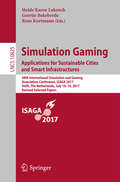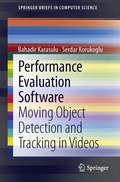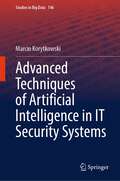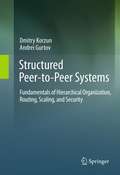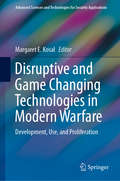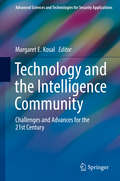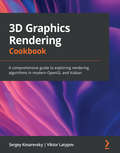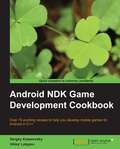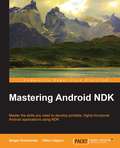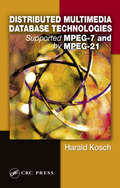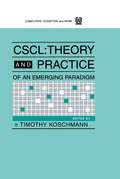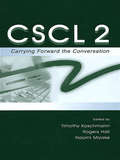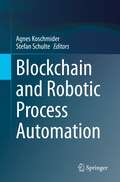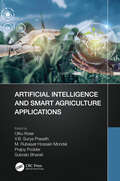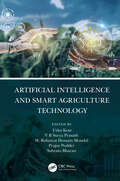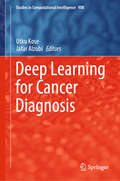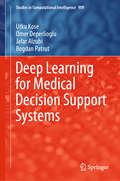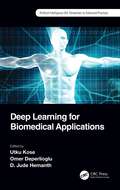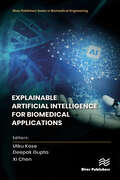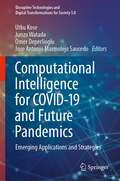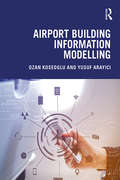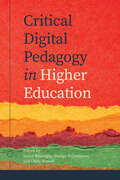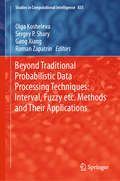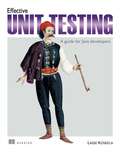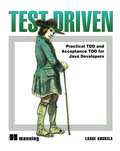- Table View
- List View
Simulation Gaming. Applications for Sustainable Cities and Smart Infrastructures: 48th International Simulation And Gaming Association Conference, Isaga 2017, Delft, The Netherlands, July 10-14, 2017, Revised Selected Papers (Theoretical Computer Science and General Issues #10825)
by Rens Kortmann Geertje Bekebrede Heide Karen LukoschThis book constitutes the refereed post-conference proceedings of the 48th International Simulation and Gaming Association Conference, ISAGA 2018, held in Delft, The Netherlands, in July 2018. The 19 revised full papers included in the volume were carefully reviewed and selected from 27 submissions. The contributions to this book range from design thinking related to simulation gaming, the analysis of the consequences of design choices in games, to games for decision making, examples of games for business, climate change, maritime spatial planning, sustainable city development, supply chain, and much more.
Performance Evaluation Software
by Serdar Korukoglu Bahadir KarasuluPerformance Evaluation Software: Moving Object Detection and Tracking in Videos introduces a software approach for the real-time evaluation and performance comparison of the methods specializing in moving object detection and/or tracking (D&T) in video processing. Digital video content analysis is an important item for multimedia content-based indexing (MCBI), content-based video retrieval (CBVR) and visual surveillance systems. There are some frequently-used generic algorithms for video object D&T in the literature, such as Background Subtraction (BS), Continuously Adaptive Mean-shift (CMS), Optical Flow (OF), etc. An important problem for performance evaluation is the absence of any stable and flexible software for comparison of different algorithms. In this frame, we have designed and implemented the software for comparing and evaluating the well-known video object D&T algorithms on the same platform. This software is able to compare them with the same metrics in real-time and on the same platform. It also works as an automatic and/or semi-automatic test environment in real-time, which uses the image and video processing essentials, e.g. morphological operations and filters, and ground-truth (GT) XML data files, charting/plotting capabilities, etc. Along with the comprehensive literature survey of the abovementioned video object D&T algorithms, this book also covers the technical details of our performance benchmark software as well as a case study on people D&T for the functionality of the software.
Advanced Techniques of Artificial Intelligence in IT Security Systems (Studies in Big Data #146)
by Marcin KorytkowskiThe book explores how modern technologies, including artificial intelligence and neural networks, are being used to enhance cybersecurity. In today's world, the development of the Internet is nothing short of transformative, affecting every aspect of our lives. Ensuring the safety of its users is a paramount concern, and it requires a diverse set of disciplines to address. Researchers from various fields, including IT, mathematics, psychology, and medicine, are collectively working to tackle this interdisciplinary challenge. The significance of this issue has been magnified by the COVID-19 pandemic, which forced many aspects of our lives into the digital realm, from online payments to remote work and education. This shift brought new security challenges, with data privacy and system integrity taking center stage. It delves into the intricacies of Big Data by having to analyze an immense volume of network traffic data that can only be effectively analyzed with specialized tools. Real-time threat detection is critical, and the book sheds light on cutting-edge approaches to achieving this goal. The content of the book covers a broad spectrum of topics related to IT system security, from user and system profiling to preventing data leaks and defending against phishing attacks. Additionally, innovative concepts such as “glial networks” are introduced, offering new ways to interpret knowledge stored in convolutional networks. These solutions are not limited to security alone; they have applications across various domains. The book highlights the advantages of these cutting-edge approaches over existing methods, demonstrating their relevance to large corporations, public institutions, schools, small businesses, and households. In a world where security threats are constantly evolving, this book is a valuable resource for understanding the dynamic landscape of network security and the role of artificial intelligence in safeguarding our digital ecosystems.
Structured Peer-to-Peer Systems
by Dmitry Korzun Andrei GurtovThe field of structured P2P systems has seen fast growth upon the introduction of Distributed Hash Tables (DHTs) in the early 2000s. The first proposals, including Chord, Pastry, Tapestry, were gradually improved to cope with scalability, locality and security issues. By utilizing the processing and bandwidth resources of end users, the P2P approach enables high performance of data distribution which is hard to achieve with traditional client-server architectures. The P2P computing community is also being actively utilized for software updates to the Internet, P2PSIP VoIP, video-on-demand, and distributed backups. The recent introduction of the identifier-locator split proposal for future Internet architectures poses another important application for DHTs, namely mapping between host permanent identity and changing IP address. The growing complexity and scale of modern P2P systems requires the introduction of hierarchy and intelligence in routing of requests. Structured Peer-to-Peer Systems covers fundamental issues in organization, optimization, and tradeoffs of present large-scale structured P2P systems, as well as, provides principles, analytical models, and simulation methods applicable in designing future systems. Part I presents the state-of-the-art of structured P2P systems, popular DHT topologies and protocols, and the design challenges for efficient P2P network topology organization, routing, scalability, and security. Part II shows that local strategies with limited knowledge per peer provide the highest scalability level subject to reasonable performance and security constraints. Although the strategies are local, their efficiency is due to elements of hierarchical organization, which appear in many DHT designs that traditionally are considered as flat ones. Part III describes methods to gradually enhance the local view limit when a peer is capable to operate with larger knowledge, still partial, about the entire system. These methods were formed in the evolution of hierarchical organization from flat DHT networks to hierarchical DHT architectures, look-ahead routing, and topology-aware ranking. Part IV highlights some known P2P-based experimental systems and commercial applications in the modern Internet. The discussion clarifies the importance of P2P technology for building present and future Internet systems.
Disruptive and Game Changing Technologies in Modern Warfare: Development, Use, and Proliferation (Advanced Sciences and Technologies for Security Applications)
by Margaret E. KosalThis book explores and analyzes emerging innovations within today’s most cutting-edge science and technology (S&T) areas, which are cited as carrying the potential to revolutionize governmental structures, economies, and international security. Some have argued that such technologies will yield doomsday scenarios and that military applications of such technologies have even greater potential than nuclear weapons to radically change the balance of power. As the United States looks to the future – whether dominated by extremist groups co-opting advanced weapons in the world of globalized non-state actors or states engaged in persistent regional conflicts in areas of strategic interest – new adversaries and new science and technology will emerge. Choices made today that affect science and technology will impact how ably the US can and will respond. Chapters within the book look at the changing strategic environment in which security operations are planned and conducted; how these impact science and technology policy choices made today; and predictions of how science and technology may play a beneficial or deleterious role in the future. Some game changing technologies have received global attention, while others may be less well known; the new technologies discussed within this proposal, as well as future discoveries, may significantly alter military capabilities and may generate new threats against military and civilian sectors.
Technology and the Intelligence Community: Challenges And Advances For The 21st Century (Advanced Sciences and Technologies for Security Applications)
by Margaret E. KosalThis volume examines the role of technology in gathering, assimilating and utilizing intelligence information through the ages. Pushing the boundaries of existing works, the articles contained here take a broad view of the use and implementation of technology and intelligence procedures during the cold war era and the space race, the September 2011 attacks, and more recent cyber operations. It looks at the development of different technologies, procedural implications thereof, and the underlying legal and ethical implications. The findings are then used to explore the future trends in technology including cyber operations, big data, open source intelligence, smart cities, and augmented reality. Starting from the core aspects of technical capabilities the articles dig deeper, exploring the hard and soft infrastructure of intelligence gathering procedures and focusing on the human and bureaucratic procedures involved therein.Technology and innovation have played an important role in determining the course of development of the intelligence community. Intelligence gathering for national security, however, is not limited only to the thread of technical capabilities but is a complex fabric of organizational structures, systemic undercurrents, and the role of personnel in key positions of decision making. The book’s findings and conclusions encompass not just temporal variation but also cut across a diverse set of issue areas. This compilation is uniquely placed in the interdisciplinary space combining the lessons from key cases in the past to current developments and implementation of technology options.
3D Graphics Rendering Cookbook: A comprehensive guide to exploring rendering algorithms in modern OpenGL and Vulkan
by Sergey Kosarevsky Viktor LatypovBuild a 3D rendering engine from scratch while solving problems in a step-by-step way with the help of useful recipesKey FeaturesLearn to integrate modern rendering techniques into a single performant 3D rendering engineLeverage Vulkan to render 3D content, use AZDO in OpenGL applications, and understand modern real-time rendering methodsImplement a physically based rendering pipeline from scratch in Vulkan and OpenGLBook DescriptionOpenGL is a popular cross-language, cross-platform application programming interface (API) used for rendering 2D and 3D graphics, while Vulkan is a low-overhead, cross-platform 3D graphics API that targets high-performance applications. 3D Graphics Rendering Cookbook helps you learn about modern graphics rendering algorithms and techniques using C++ programming along with OpenGL and Vulkan APIs.The book begins by setting up a development environment and takes you through the steps involved in building a 3D rendering engine with the help of basic, yet self-contained, recipes. Each recipe will enable you to incrementally add features to your codebase and show you how to integrate different 3D rendering techniques and algorithms into one large project. You'll also get to grips with core techniques such as physically based rendering, image-based rendering, and CPU/GPU geometry culling, to name a few. As you advance, you'll explore common techniques and solutions that will help you to work with large datasets for 2D and 3D rendering. Finally, you'll discover how to apply optimization techniques to build performant and feature-rich graphics applications.By the end of this 3D rendering book, you'll have gained an improved understanding of best practices used in modern graphics APIs and be able to create fast and versatile 3D rendering frameworks.What you will learnImprove the performance of legacy OpenGL applicationsManage a substantial amount of content in real-time 3D rendering enginesDiscover how to debug and profile graphics applicationsUnderstand how to use the Approaching Zero Driver Overhead (AZDO) philosophy in OpenGLIntegrate various rendering techniques into a single applicationFind out how to develop Vulkan applicationsImplement a physically based rendering pipeline from scratchIntegrate a physics library with your rendering engineWho this book is forThis book is for 3D graphics developers who are familiar with the mathematical fundamentals of 3D rendering and want to gain expertise in writing fast rendering engines with advanced techniques using C++ libraries and APIs. A solid understanding of C++ and basic linear algebra, as well as experience in creating custom 3D applications without using premade rendering engines is required.
Android NDK Game Development Cookbook
by Sergey Kosarevsky Viktor LatypovA systematic guide consisting of over 70 recipes which focus on helping you build portable mobile games and aims to enhance your game development skills with clear instructions.If you are a C++ developer who wants to jump into the world of Android game development and who wants to use the power of existing C++ libraries in your existing Android Java applications, then this book is for you. You need to have basic knowledge of C or C++ including pointer manipulation, multithreading, and object-oriented programming concepts as well as some experience developing applications without using an IDE.
Mastering Android NDK
by Sergey Kosarevsky Viktor LatypovMaster the skills you need to develop portable, highly-functional Android applications using NDK About This Book * Develop portable games using Android NDK and debug them on your desktop * Familiarise yourself with different popular C++ libraries on Android and use them in your games * Write multi-threaded code with graphics, sound, networking, and resource storage Who This Book Is For If you want to leverage your C++ skills in mobile development and increase the performance of your Android applications, then this is the book for you. Knowledge of C or C++ is assumed, including pointer manipulation, multi-threading, object-oriented programming concepts, and the basics of C++11. It would be an added advantage if you know how to develop applications without any IDE. What You Will Learn * Explore different popular C++ libraries and import some of them to Android * Write portable, multithreaded native code * Create applications that play audio with OpenAL * Implement gesture recognition in your games and applications * Debug mobile applications on your desktop * Extract resources from APK archives * Render text with FreeType and also use OpenGL ES In Detail Android NDK is used for multimedia applications that require direct access to system resources. NDK is also the key for portability, which in turn allows a reasonably comfortable development and debugging process using familiar tools such as GCC and Clang toolchains. This is a hands-on guide to extending your game development skills with Android NDK. The book takes you through many clear, step-by-step example applications to help you further explore the features of Android NDK and some popular C++ libraries and boost your productivity by debugging the development process. Through the course of this book, you will learn how to write portable multi-threaded native code, use HTTP networking in C++, play audio files, use OpenGL ES 3, and render high-quality text. Each chapter aims to take you one step closer to building your application. By the end of this book, you will be able to create an engaging, complete gaming application. Style and approach This book adopts a step-by-step approach and each chapter is based on the material from the previous ones. The book focuses on putting to your knowledge of C++ use while you develop Android applications of your own.
Distributed Multimedia Database Technologies Supported by MPEG-7 and MPEG-21
by Harald KoschA multimedia system needs a mechanism to communicate with its environment, the Internet, clients, and applications. MPEG-7 provides a standard metadata format for global communication, but lacks the framework to let the various players in a system interact. MPEG-21 closes this gap by establishing an infrastructure for a distributed multimedia frame
Cscl: Theory and Practice of An Emerging Paradigm
by Timothy KoschmannThis book, about a newly emerging area of research in instructional technology, has as its title the acronym "CSCL." Initially, CSCL was chosen as an acronym for Computer-Supported Collaborative Learning. However, some would argue that "collaborative" is often not a descriptive term for what learners do in instructional settings; further, as the field develops, the technology used to support collaboration may not always involve computers, at least not in the direct ways they have been used to support instruction in the past. To avoid getting bogged down in this terminological debate, this book uses CSCL as a designation in its own right, leaving open to interpretation precisely what words it stands for. The authors talk a great deal about the theory underlying their work. In part, this is because that is what they were asked to do, but it is also an indication of the state of the field. In an established paradigm in which the theories and methods are well agreed upon, such discussion is less central. CSCL, however, has not yet reached the stage of "normal" science. There is much to be worked out yet. This book is offered with the hope that it will help to define a direction for future work in this field. The chapters appear in alphabetical order (except for the introductory chapter and the afterword) -- not for lack of a better way to organize the chapters, but rather because the organizational possibilities are too numerous and this order does not privilege one over another. By not imposing a topical organizing structure on this collection, it is hoped that readers will feel freer to explore the chapters in a way that best suits their needs. COPY FOR BIND-CARD CD-ROM info ................................. There is an accompanying CD-Rom for this proceedings that will become available September 1998. Purchasers of the proceedings may obtain a copy of this CD-ROM at no cost by contacting Lawrence Erlbaum Associates, Inc. phone: (201) 236-9500 toll-free: 1-800-9-BOOKS-9 (1-800-926-6579) 9am-5pm EST fax: (201) 236-0072 e-mail: orders@erlbaum.com Web site: www.erlbaum.com address: 10 Industrial Avenue, Mahwah, NJ 07430-2262 The CD-ROM was funded through a grant from the National Science Foundation.
Cscl 2: Carrying Forward the Conversation
by Timothy Koschmann Rogers Hall Naomi MiyakeCSCL 2: Carrying Forward the Conversation is a thorough and up-to-date survey of recent developments in Computer Supported Collaborative Learning, one of the fastest growing areas of research in the learning sciences. A follow-up to CSCL: Theory and Practice of an Emerging Paradigm (1996), this volume both documents how the field has grown and fosters a meaningful discussion of how the research program might be advanced in substantive ways. Recognizing the long-standing traditions of CSCL work in Europe and Japan, the editors sought to broaden and expand the conversation both geographically and topically. The 45 participating authors represent a range of disciplinary backgrounds, including anthropology, communication studies, computer science, education, psychology, and philosophy, and offer international perspectives on the field. For each chapter, the goal was not only to show how it connects to past and future work in CSCL, but also how it contributes to the interests of other research communities. Toward this end, the volume features a "conversational structure" consisting of target chapters, invited commentaries, and author responses. The commentaries on each chapter were solicited from a diverse collection of writers, including prominent scholars in anthropology of education, social studies of science, CSCW, argumentation, activity theory, language and social interaction, ecological psychology, and other areas. The volume is divided into three sections: *Part I explores four case studies of technology transfer involving CSILE, one of the most prominent CSCL projects. *Part II focuses on empirical studies of learning in collaborative settings. *Part III describes novel CSCL technologies and the theories underlying their design. Historically, there has been a certain amount of controversy as to what the second "C" in CSCL should represent. The conventional meaning is "collaborative" but there are many C-words that can be seen as relevant. With the publication of this volume, "conversational" might be added to the list and, in this spirit, the book might be viewed as an invitation to join a conversation in progress and to carry it forward.
Blockchain and Robotic Process Automation
by Agnes Koschmider Stefan SchulteThis book integrates the material of the lecture series “Blockchain and Robotic Process Automation”, offered at Kiel University. The lecture series sheds light on current research topics on blockchain and robotic process automation (RPA) also in combination with business process management (BPM) or process mining. In this series, leading scientists and business experts give insights into the use of the blockchain technology and RPA. The seven contributions included offer a general introduction into blockchain and smart contracts, and detail the extraction of meaningful events for process mining from blockchain, challenges of blockchain-based collaborative business processes, executing Decision Model and Notation decisions on the blockchain, a blockchain-based solution for digital payment, blockchain use cases in transportation and logistics, and automatically identifying process automation candidates using natural language processing. Overall, the book provides researchers and graduate students with a basic introduction into blockchain, its applications, useful combinations of BPM and blockchain, and use cases for RPA.
Artificial Intelligence and Smart Agriculture Applications
by Utku KoseAn essential resource work for understanding how to design and develop smart applications for present and future problems of the field of agriculture.— Dr. Deepak Gupta, Maharaja Agrasen Institute of Technology, Delhi, India As a result of the advances in Artificial Intelligence (AI), many aspects of daily life have been transformed by smart digital technology. Advanced intelligent algorithms can provide powerful solutions to real-world problems. Smart applications have become commonplace. All areas of life are being changed by smart tools developed to deal with complex issues challenging both humanity and the earth. Artificial Intelligence and Smart Agriculture Applications presents the latest smart agriculture applications developed across the globe. It covers a broad array of solutions using data science and AI to attack problems facing agriculture worldwide. Features: Application of drones and sensors in advanced farming A cloud-computing model for implementing smart agriculture Conversational AI for farmer's advisory communications Intelligent fuzzy logic to predict global warming’s effect on agriculture Machine learning algorithms for mapping soil macronutrient elements variability A smart IoT framework for soil fertility enhancement AI applications in pest management A model using Python for predicting rainfall The book examines not only present solutions but also potential future outcomes. It looks at the role of AI-based algorithms and the almost infinite combinations of variables for agricultural applications. Researchers, public and private sector representatives, agriculture scientists, and students can use this book to develop sustainable and solutions for smart agriculture. This book’s findings are especially important as the planet is facing unprecedented environmental challenges from over-farming and climate change due to global warming.
Artificial Intelligence and Smart Agriculture Technology
by Utku KoseThis book was created with the intention of informing an international audience about the latest technological aspects for developing smart agricultural applications. As artificial intelligence (AI) takes the main role in this, the majority of the chapters are associated with the role of AI and data analytics components for better agricultural applications. The first two chapters provide alternative, wide reviews of the use of AI, robotics, and the Internet of Things as effective solutions to agricultural problems. The third chapter looks at the use of blockchain technology in smart agricultural scenarios. In the fourth chapter, a future view is provided of an Internet of Things-oriented sustainable agriculture. Next, the fifth chapter provides a governmental evaluation of advanced farming technologies, and the sixth chapter discusses the role of big data in smart agricultural applications. The role of the blockchain is evaluated in terms of an industrial view under the seventh chapter, and the eighth chapter provides a discussion of data mining and data extraction, which is essential for better further analysis by smart tools. The ninth chapter evaluates the use of machine learning in food processing and preservation, which is a critical issue for dealing with issues concerns regarding insufficient foud sources. The tenth chapter also discusses sustainability, and the eleventh chapter focuses on the problem of plant disease prediction, which is among the critical agricultural issues. Similarly, the twelfth chapter considers the use of deep learning for classifying plant diseases. Finally, the book ends with a look at cyber threats to farming automation in the thirteenth chapter and a case study of India for a better, smart, and sustainable agriculture in the fourteenth chapter. This book presents the most critical research topics of today’s smart agricultural applications and provides a valuable view for both technological knowledge and ability that will be helpful to academicians, scientists, students who are the future of science, and industrial practitioners who collaborate with academia.
Deep Learning for Cancer Diagnosis (Studies in Computational Intelligence #908)
by Utku Kose Jafar AlzubiThis book explores various applications of deep learning to the diagnosis of cancer,while also outlining the future face of deep learning-assisted cancer diagnostics. As is commonly known, artificial intelligence has paved the way for countless new solutions in the field of medicine. In this context, deep learning is a recent and remarkable sub-field, which can effectively cope with huge amounts of data and deliver more accurate results. As a vital research area, medical diagnosis is among those in which deep learning-oriented solutions are often employed.Accordingly, the objective of this book is to highlight recent advanced applications of deep learning for diagnosing different types of cancer. The target audience includes scientists, experts, MSc and PhD students, postdocs, and anyone interested in the subjects discussed. The book can be used as a reference work to support courses on artificial intelligence, medical and biomedicaleducation.
Deep Learning for Medical Decision Support Systems (Studies in Computational Intelligence #909)
by Utku Kose Omer Deperlioglu Jafar Alzubi Bogdan PatrutThis book explores various applications of deep learning-oriented diagnosis leading to decision support, while also outlining the future face of medical decision support systems. Artificial intelligence has now become a ubiquitous aspect of modern life, and especially machine learning enjoysgreat popularity, since it offers techniques that are capable of learning from samples to solve newly encountered cases. Today, a recent form of machine learning, deep learning, is being widely used with large, complex quantities of data, because today’s problems require detailed analyses of more data. This is critical, especially in fields such as medicine. Accordingly, the objective of this book is to provide the essentials of and highlight recent applications of deep learning architectures for medical decision support systems. The target audience includes scientists, experts, MSc and PhD students, postdocs, and any readers interested in the subjectsdiscussed. The book canbe used as a reference work to support courses on artificial intelligence, machine/deep learning, medical and biomedicaleducation.
Deep Learning for Biomedical Applications (Artificial Intelligence (AI): Elementary to Advanced Practices)
by Utku Kose Omer Deperlioglu D. Jude HemanthThis book is a detailed reference on biomedical applications using Deep Learning. Because Deep Learning is an important actor shaping the future of Artificial Intelligence, its specific and innovative solutions for both medical and biomedical are very critical. This book provides a recent view of research works on essential, and advanced topics. The book offers detailed information on the application of Deep Learning for solving biomedical problems. It focuses on different types of data (i.e. raw data, signal-time series, medical images) to enable readers to understand the effectiveness and the potential. It includes topics such as disease diagnosis, image processing perspectives, and even genomics. It takes the reader through different sides of Deep Learning oriented solutions. The specific and innovative solutions covered in this book for both medical and biomedical applications are critical to scientists, researchers, practitioners, professionals, and educations who are working in the context of the topics.
Explainable Artificial Intelligence for Biomedical Applications (River Publishers Series in Biomedical Engineering)
by Utku Kose Deepak Gupta Xi ChenSince its first appearance, artificial intelligence has been ensuring revolutionary outcomes in the context of real-world problems. At this point, it has strong relations with biomedical and today’s intelligent systems compete with human capabilities in medical tasks. However, advanced use of artificial intelligence causes intelligent systems to be black-box. That situation is not good for building trustworthy intelligent systems in medical applications. For a remarkable amount of time, researchers have tried to solve the black-box issue by using modular additions, which have led to the rise of the term: interpretable artificial intelligence. As the literature matured (as a result of, in particular, deep learning), that term transformed into explainable artificial intelligence (XAI). This book provides an essential edited work regarding the latest advancements in explainable artificial intelligence (XAI) for biomedical applications. It includes not only introductive perspectives but also applied touches and discussions regarding critical problems as well as future insights. Topics discussed in the book include: XAI for the applications with medical images XAI use cases for alternative medical data/task Different XAI methods for biomedical applications Reviews for the XAI research for critical biomedical problems. Explainable Artificial Intelligence for Biomedical Applications is ideal for academicians, researchers, students, engineers, and experts from the fields of computer science, biomedical, medical, and health sciences. It also welcomes all readers of different fields to be informed about use cases of XAI in black-box artificial intelligence. In this sense, the book can be used for both teaching and reference source purposes.
Computational Intelligence for COVID-19 and Future Pandemics: Emerging Applications and Strategies (Disruptive Technologies and Digital Transformations for Society 5.0)
by Utku Kose Junzo Watada Omer Deperlioglu Jose Antonio Marmolejo SaucedoThe book covers a wide topic collection starting from essentials of Computational Intelligence to advance, and possible application types against COVID-19 as well as its effects on the field of medical, social, and different data-oriented research scopes. Among these topics, the book also covers very recently, vital topics in terms of fighting against COVID-19 and solutions for future pandemics. The book includes the use of computational intelligence for especially medical diagnosis and treatment, and also data-oriented tracking-predictive solutions, which are key components currently for fighting against COVID-19. In this way, the book will be a key reference work for understanding how computational intelligence and the most recent technologies (i.e. Internet of Healthcare Thing, big data, and data science techniques) can be employed in solution phases and how they change the way of future solutions. The book also covers research works with negative results so that possible disadvantages of using computational intelligence solutions and/or experienced side-effects can be known widely for better future of medical solutions and use of intelligent systems against COVID-19 and pandemics. The book is considering both theoretical and applied views to enable readers to be informed about not only research works but also theoretical views about essentials/components of intelligent systems against COVID-19/pandemics, possible modeling scenarios with current and future perspective as well as solution strategies thought by researchers all over the world.
Airport Building Information Modelling
by Ozan Koseoglu Yusuf ArayiciThis book details how Building Information Modelling is being successfully deployed in the planning, design, construction and future operation of the Istanbul New Airport, a mega-scale construction project incorporating a varying mix of infrastructures including terminals, runways, passenger gates, car parks, railways and roads. The book demonstrates how Airport Building Information Modelling (ABIM) is being used to: • facilitate collaboration, cooperation and integrated project delivery • manage subcontractors and eliminate cost over-runs • reduce waste on site and enhance overall quality • connect people in a virtual environment to encourage collaborative working • provide clients with an effective interface for lifecycle management including: design development, construction documentation, construction phases and BIM and Big Data Integration for future facilities management The book presents a best practice BIM project, demonstrating concurrent engineering, lean processes, collaborative design and construction, and effective construction management. Moreover, the book provides a visionary exemplar for the further use of BIM technologies in civil engineering projects including highways, railways and others on the way towards the Smart City vision. It is essential reading for all Built Environment and Engineering stakeholders.
Critical Digital Pedagogy in Higher Education (Issues in Distance Education)
by Suzan Köseoğlu George Veletsianos Chris RowellRecent efforts to solve the problems of education—created by neoliberalism in and out of higher education—have centred on the use of technology that promises efficiency, progress tracking, and automation. The editors of this volume argue that using technology in this way reduces learning to a transaction. They ask administrators, instructors, and learning designers to reflect on our relationship with these tools and explore how to cultivate a pedagogy of care in an online environment. With an eye towards identifying different and better possibilities, this collection investigates previously under-examined concepts in the field of digital pedagogy such as shared learning and trust, critical consciousness, change, and hope.
Beyond Traditional Probabilistic Data Processing Techniques: Interval, Fuzzy etc. Methods and Their Applications (Studies in Computational Intelligence #835)
by Olga Kosheleva Sergey P. Shary Gang Xiang Roman ZapatrinData processing has become essential to modern civilization. The original data for this processing comes from measurements or from experts, and both sources are subject to uncertainty. Traditionally, probabilistic methods have been used to process uncertainty. However, in many practical situations, we do not know the corresponding probabilities: in measurements, we often only know the upper bound on the measurement errors; this is known as interval uncertainty. In turn, expert estimates often include imprecise (fuzzy) words from natural language such as "small"; this is known as fuzzy uncertainty. In this book, leading specialists on interval, fuzzy, probabilistic uncertainty and their combination describe state-of-the-art developments in their research areas. Accordingly, the book offers a valuable guide for researchers and practitioners interested in data processing under uncertainty, and an introduction to the latest trends and techniques in this area, suitable for graduate students.
Effective Unit Testing: A guide for Java developers
by Lasse KoskelaSummaryEffective Unit Testing is written to show how to write good tests—tests that are concise and to the point, expressive, useful, and maintainable. Inspired by Roy Osherove's bestselling The Art of Unit Testing, this book focuses on tools and practices specific to the Java world. It introduces you to emerging techniques like behavior-driven development and specification by example, and shows you how to add robust practices into your toolkit.About TestingTest the components before you assemble them into a full application, and you'll get better software. For Java developers, there's now a decade of experience with well-crafted tests that anticipate problems, identify known and unknown dependencies in the code, and allow you to test components both in isolation and in the context of a full application.About this BookEffective Unit Testing teaches Java developers how to write unit tests that are concise, expressive, useful, and maintainable. Offering crisp explanations and easy-to-absorb examples, it introduces emerging techniques like behavior-driven development and specification by example.Programmers who are already unit testing will learn the current state of the art. Those who are new to the game will learn practices that will serve them well for the rest of their career. Purchase of the print book comes with an offer of a free PDF, ePub, and Kindle eBook from Manning. Also available is all code from the book. About the AuthorLasse Koskela is a coach, trainer, consultant, and programmer. He hacks on open source projects, helps companies improve their productivity, and speaks frequently at conferences around the world. Lasse is the author of Test Driven, also published by Manning.What's InsideA thorough introduction to unit testingChoosing best-of-breed toolsWriting tests using dynamic languagesEfficient test automationTable of ContentsPART 1 FOUNDATIONSThe promise of good testsIn search of goodTest doublesPART 2 CATALOGReadabilityMaintainabilityTrustworthinessPART 3 DIVERSIONSTestable designWriting tests in other JVM languagesSpeeding up test execution
Test Driven: Practical TDD and Acceptance TDD for Java Developers
by Lasse KoskelaIn test driven development, you first write an executable test ofwhat your application code must do. Only then do you write thecode itself and, with the test spurring you on, you improve yourdesign. In acceptance test driven development (ATDD), you usethe same technique to implement product features, benefiting fromiterative development, rapid feedback cycles, and better-definedrequirements. TDD and its supporting tools and techniques leadto better software faster.Test Driven brings under one cover practical TDD techniquesdistilled from several years of community experience. With examplesin Java and the Java EE environment, it explores both the techniquesand the mindset of TDD and ATDD. It uses carefully chosen examplesto illustrate TDD tools and design patterns, not in the abstractbut concretely in the context of the technologies you face at work.It is accessible to TDD beginners, and it offers effective and less wellknown techniques to older TDD hands. Purchase of the print book comes with an offer of a free PDF, ePub, and Kindle eBook from Manning. Also available is all code from the book. What's InsideLearn hands-on to test drive Java codeHow to avoid common TDD adoption pitfallsAcceptance test driven development and the Fit frameworkHow to test Java EE components-Servlets, JSPs, and SpringControllersTough issues like multithreaded programs and data access code
